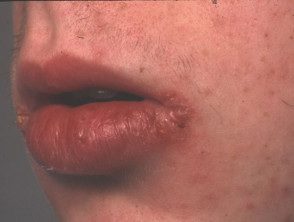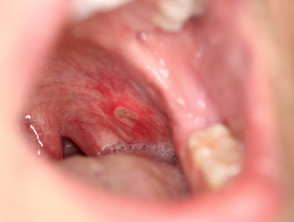What is orofacial Crohn disease?
Orofacial Crohn disease is a specific manifestation of Crohn disease, an inflammatory bowel disease. There are several clinical presentations in the mouth and affecting facial skin, that on histology show the non-caseating granulomas typical of Crohn disease. It is clinically and histologically indistinguishable from orofacial granulomatosis, but occurs only in association with Crohn disease of the bowel.
Skin complications of Crohn disease
Who gets orofacial Crohn disease?
Orofacial Crohn disease occurs only in patients with Crohn disease of the bowel, either at the same time as the bowel symptoms present, in association with a flare of bowel symptoms in someone already known to have Crohn disease, or it may precede the Crohn disease diagnosis. Estimates of specific changes in the mouth of Crohn disease range from 0.5% to 20% and may reflect patient age and race, whether the patient was on treatment at the time of the examination and expertise of the examiner.
Although orofacial Crohn disease can affect all age groups, it has been suggested that it is more common in children than adults, with up to 50% of children affected in some series. Particularly in children, this can be an important clinical presentation of Crohn disease and may develop before the bowel symptoms and diagnosis. Usually the bowel disease develops within a few months of the orofacial condition, but delays of up to 9 years have also been reported.
The specific orofacial signs of Crohn disease may be either due to contiguous disease from the gastrointestinal tract or metastatic.
Clinical presentation of orofacial Crohn disease
Signs of orofacial Chrohn disease include:
- mucogingivitis (inflammation of the gums)
- mucosal tags
- deep linear ulcers in the fold between the cheek and gum
- cobblestoning of the lining of the inside of the cheeks
- lip swelling (macrochelia), with or without fissuring
- metastatic Crohn disease involving skin of the face may present as ulcers, papules, nodules, plaques or persistent swelling
Most paediatric patients had more than one manifestation in the mouth in studies in which an expert paediatric dentist examined the mouths of children with suspected inflammatory bowel disease before commencing treatment. However, these were commonly missed by non-dental practitioners.
Often these signs in the mouth are asymptomatic and the patient may be quite unaware of them. They can improve with time and with treatment of the bowel disease. However, they may cause significant symptoms and require specific treatment. Symptoms can include:
- Pain – on touch or when eating acidic or spicy foods
- Impaired eating, speaking, swallowing
- Psychological distress due to cosmetic appearance
How is orofacial Crohn disease diagnosed?
Deep incisional biopsy very commonly shows noncaseating granulomas which may be the deciding factor in distinguishing Crohn disease from ulcerative colitis. Special stains must be performed to exclude other causes of granulomas such as foreign material or infection.
Treatment of orofacial Crohn disease
Treatment options include:
- Cinnamate- and benzoate-free diet
- Corticosteroid mouthwash
- Immunosuppressive treatment including systemic steroid and azathioprine as for bowel disease

